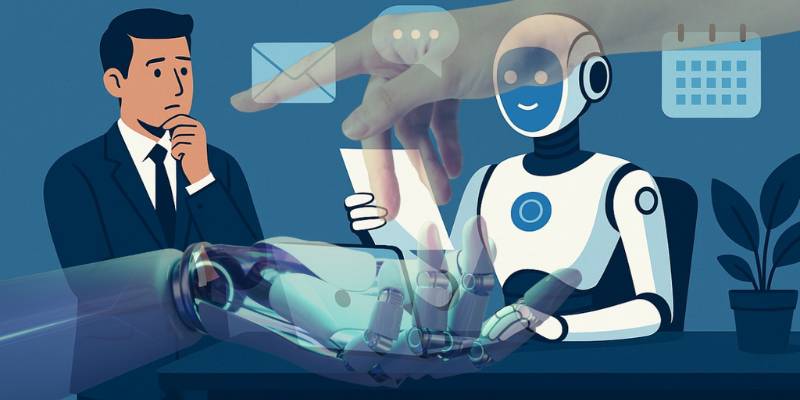Do you remember Clippy? That wide-eyed, bendy paperclip that would pop up in Microsoft Word and cheerfully (sometimes annoyingly) ask, “It looks like you’re writing a letter.
Would you like some help?” For many of us, Clippy was the first brush with what we’d later call an AI assistant. Back then, it was quirky, rudimentary, and often more irritating than useful.
Fast forward to today, and we’re living in a completely different reality. AI assistants now sit in our pockets, in our homes, and in our offices, quietly powering interactions that range from playing music to scheduling meetings.
But how did we get from Clippy’s clunky interruptions to GPT-powered companions that can write essays, answer complex questions, and even offer emotional support?
That’s what this article will explore: the full arc of AI assistants’ evolution. I’ll take you through the milestones, the technological leaps, the cultural controversies, and yes—even the human feelings we project onto these digital helpers.
This isn’t just history; it’s also a personal reflection, a critical analysis, and—hopefully—a complete guide to AI Assistants in the Workplace and beyond.
Chapter 1: The Early Years – Clippy and Friends
Let’s be honest: Clippy was both loved and hated. Microsoft introduced it in Office 97, and while it was supposed to make tasks easier, most people just wanted to shut it down.
Why? Because Clippy wasn’t really intelligent—it followed rigid, rule-based logic. If it saw the word “Dear,” it assumed you were writing a letter. Helpful? Maybe once. Frustrating? Almost always.
But Clippy wasn’t alone. Around the same era, we saw the rise of primitive chatbots. ELIZA, developed in the 1960s, already set the stage by mimicking a therapist through simple pattern-matching responses.
Later, AOL Instant Messenger had bots that could give you jokes or weather updates. These were playful experiments, not serious tools.
And yet, even then, one thing was clear: humans wanted to talk to machines. We craved not just functionality, but interaction.
Chapter 2: The Voice Revolution – Siri, Alexa, and Google Assistant
Everything shifted in 2011 when Apple introduced Siri. Suddenly, you didn’t have to click or type—you could just ask. Want the weather? Want to set a reminder? Siri could handle it. It felt futuristic, like something out of Star Trek.
Of course, Siri was limited at launch, but it sparked a movement. Amazon followed with Alexa in 2014, and Google Assistant entered the scene in 2016. Voice assistants were marketed as companions for the smart home. Alexa could turn off your lights, play your favorite playlist, and order more paper towels.
It wasn’t perfect—how many of us have had to shout, “No, I said play jazz, not ‘call Jess’”? Still, these assistants made AI feel personal.
What’s fascinating is the psychology: people named their assistants, said “please” and “thank you,” and even reported feeling guilty when being rude to them.
This emotional entanglement was an early sign that AI assistants weren’t just tools. They were beginning to blur the line between utility and companionship.
Chapter 3: The GPT Era – Context, Creativity, and Companionship
Then came the real game-changer: large language models. When OpenAI released GPT-3 in 2020, and later GPT-4, it was like the ground shifted under our feet.
For the first time, an AI assistant could generate content that wasn’t just formulaic—it was coherent, creative, and context-aware.
You could ask it to draft an email, write code, summarize a book, or roleplay as a mentor. It wasn’t limited to narrow commands; it could converse. This is what made people say, “Whoa, this feels almost human.”
And unlike Clippy or Siri, GPT assistants learned from vast datasets, which gave them flexibility and nuance. But with this came a new set of debates:
- Creativity vs. Authenticity: Was GPT truly creative, or just remixing existing content?
- Productivity vs. Dependency: Were we empowering ourselves, or outsourcing too much of our thinking?
- Efficiency vs. Humanity: Which leads us straight into the controversy around Can AI Replace Personal Secretaries? A Deep Dive into Efficiency vs. Human Touch.
Chapter 4: The Workplace Transformation
Let’s zoom in on the workplace, because this is where AI assistants have had the most tangible impact.
Think of all the things AI can do now:
- Transcribe meetings in real-time.
- Draft project reports in minutes.
- Summarize hundreds of emails into a quick digest.
- Automate scheduling across multiple time zones.
For managers and employees drowning in administrative tasks, this is a lifeline. According to a 2023 PwC report, businesses using AI to automate workflows saw up to a 40% improvement in productivity.
This is why I call it a complete guide to AI Assistants in the Workplace—not because everything is solved, but because we now have a toolkit that’s evolving faster than most people can keep up with.
But—here’s the human side—many workers feel anxious. If AI can do the tedious parts of my job, does that make me more valuable, or less? Will I be free to focus on strategy and creativity, or will my role be replaced altogether?
These aren’t abstract fears. They’re lived experiences, and they’re reshaping how people view technology in professional settings.
Chapter 5: The Human Touch vs. Machine Efficiency
Here’s where it gets tricky. A personal secretary or executive assistant isn’t just someone who manages your calendar. They understand your moods, anticipate needs, and protect your time in ways that are deeply human.
Can AI replicate that?
Well, AI can be efficient—sometimes breathtakingly so. It can scan thousands of data points in seconds. But empathy? Nuance? Subtle human cues? That’s where machines falter.
So when people debate the controversy around Can AI Replace Personal Secretaries? A Deep Dive into Efficiency vs. Human Touch, I often lean toward this: AI can be an incredible partner, but it’s not a replacement.
Efficiency matters, but so does trust, loyalty, and that quiet reassurance that only a human can give.
Chapter 6: Privacy Concerns – Explained
Of course, no conversation about AI assistants would be complete without talking about trust. If you’re inviting a machine into your home, your phone, or your office, you’re also handing over data. And that data can be sensitive.
Consider this: voice assistants are often “always listening.” Smart assistants track your queries, your preferences, sometimes even your location. The question of who controls this data—and how it’s used—remains unsettled.
The explained: Privacy Concerns section isn’t just about data leaks. It’s about power. Who benefits from the knowledge AI assistants gather? Tech companies? Governments? You?
Surveys show that over 70% of Americans worry about how companies use their data collected by AI assistants (Pew Research, 2023). And honestly, I share that worry. I find myself hesitating before asking Alexa certain things, because I don’t fully trust where that information goes.
That hesitation, that pause—that’s the human side of this story.
Chapter 7: The Cultural Layer – Emotions, Trust, and Banter
AI assistants aren’t just tools; they’ve become cultural characters. Remember the movie Her? Or even the satirical jokes about arguing with Siri?
There’s humor, frustration, even affection in how we talk about these assistants. Some people describe GPT models as “friends” or “mentors.” Others describe them as cold, corporate spies.
This cultural push-and-pull is what makes the field so fascinating. It’s not just about what AI can do—it’s about how humans feel about it. And feelings, as we know, are messy, imperfect, and often contradictory.
Chapter 8: Discover The Battle of AI Assistants Perspectives
It’s not just about technology; it’s also about competition. Microsoft has Copilot. Google has Bard. Amazon has Alexa. Apple has Siri. OpenAI has ChatGPT.
Each company has a vision, and each one is vying to win our attention, our loyalty, and our trust.
This isn’t just a business story—it’s ideological. Microsoft emphasizes productivity, Google leans on information retrieval, Apple stresses privacy, and OpenAI emphasizes creativity.
So when you discover The Battle of AI Assistants perspectives, what you’re really uncovering is a debate about what kind of relationship we want with technology. Do we want it to be a servant? A partner? A colleague? A friend?
Chapter 9: Imperfections, Limitations, and Honest Reflection
I’d be lying if I said AI assistants are flawless. They hallucinate. They misinterpret. They sometimes feel too eager to please. And yes, I’ve had my fair share of yelling at Alexa or laughing at a bizarre GPT-generated answer.
But here’s the thing: imperfection is part of evolution. Humans didn’t get language right on the first try either. Tools grow with us, and we grow with them.
My personal take? These assistants are mirrors. They reflect not only our words but our values, fears, and hopes. That’s why they fascinate us—and frustrate us.
Chapter 10: Looking Ahead – What Comes Next?
So where do we go from here?
I see three possible futures:
- The Integration Future
AI assistants become fully woven into daily life, quietly handling tasks without us even noticing. - The Companion Future
AI evolves into deeply personalized, emotionally responsive companions—more “Her” than “Clippy.” - The Regulatory Future
Governments step in with strict rules around privacy, transparency, and ethical AI.
The reality will probably be a blend of all three.
But one thing is certain: AI assistants aren’t going away. They’re becoming as common as smartphones, and in many ways, they’ll define how we live, work, and connect in the decades ahead.
Conclusion
From Clippy’s cheerful interruptions to GPT’s nuanced conversations, the journey of AI assistants tells us as much about ourselves as it does about machines. We’ve gone from tolerating interruptions to seeking companionship, from dismissing digital helpers to relying on them daily.
Along the way, we’ve faced questions of trust, privacy, efficiency, and humanity. And we’ll keep facing them, because these aren’t just technical questions—they’re existential ones.
Do we want machines to be tools, or partners? Do we measure value by speed, or by empathy?
I don’t pretend to have all the answers, but I do know this: the story of AI assistants is really the story of us—our needs, our creativity, our flaws, and our endless drive to make the world just a little easier to navigate.


